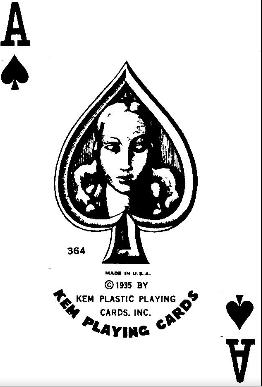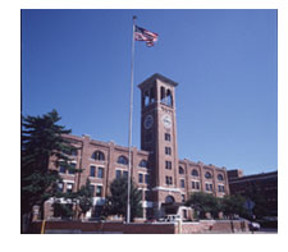The Strange and Interesting History of the United States Playing Card Company
Written by Howard Fosdick © BestFreeNewGames.com
A playing card company with a radio broadcasting tower? One that tried to kill off Bridge in favor of 500? One that contributed to the war effort in both World War II and the Vietnam War? What’s with the United States Playing Card Company? Here’s the real story...
The United States Playing Card company (USPC) is the oldest and largest manufacturer of playing cards in the United States. The USPC evolved from a printing press purchased from the Cincinnati Enquirer newspaper at the end of the Civil War. The owners of the press were looking for new products to manufacture and they decided on playing cards in 1881. USPC still manufactures one of their first designs today -- the “Congress” playing cards.
Bicycles were the big fad of the late 19th century. Races were popular and their winners were nationally-known. Everyone was learning to ride (or pretending to!). So it was natural that USPC produced their “Bicycle” design cards starting in 1885. Like the Congress design, Bicycle cards are still a best-selling playing card today.
By the early 20th century, the public’s attention had shifted to the new excitement of flight. This prompted USPC to introduce their “Aviator” cards. Aviators initially displayed biplanes on their backs. Over the years USPC upgraded the airplane design to single-winged propeller planes, and later to commercial passenger jets. USPC ultimately gave up changing the design to suit new airplane technologies – today Aviators have a traditional pattern back rather than an airplane on them. (Personally, I wish they had kept the airplane backs from the old decks from the 1970s!)

USPC also makes “Bee,” “Maverick,” and “Hoyle” design playing cards. And they own Kem, the makers of high-end plastic playing cards invented in the 1930’s. Ely Culbertson had signed with Kem Cards in a promotional deal that yielded him a life-long income.
The Ace of Spades you see here is Kem plastic playing card with the original 1935 copyright. Note the woman’s short-cropped hair worn close to her head and the fur surrounding her shoulders. She unsmilingly looks to her left. Definitely an iconic 1930’s image!
The USPC made unique contributions to several American wars. In World War II, the company produced special cards that could be peeled apart to reveal maps and escape routes. These were sent to US troops in Nazi prisoner-of-war camps.
During the Vietnam War, USPC produced special decks consisting solely of Aces of Spades. The Viet Cong had been influenced by fortune-tellers who interpreted the Ace of Spades as predicting death and sorrow. Troops used these special cards as a form of psychological warfare, making sure the Viet Cong would find them at appropriate times.
The USPC also made the famous Iraq War deck, featuring pictures of Saddam Hussein and the Iraqi leadership. This was popularized during the second American-Iraq war in 2003.
Until 2009, the USPC resided in Cincinnati, Ohio, in the building pictured below. The tall tower you see was used by the USPC to broadcast radio programs. The company promoted Bridge and other card games through these broadcasts, capitalizing on the radio boom of the 1920’s. Eventually radio settled into its modern form of broadcast networks, and USPC sold their radio station to Crosley Radio Corporation (Crosley went on to become a famous Cincinnati-based manufacturer of radios in the ‘20s and ‘30s; and you’ll still see Crosley-labeled radios today).
Back when the USPC broadcast as station WSAI on the AM band, federal regulators had not yet caught up with radio, and the station was so powerful it could be heard as far away as New Zealand!

USPC employees have invented many card games. For some reason now lost to history, back around 1900 the company wanted to curtail the growing popularity of Bridge. (Who knows why they cared, since whether people play Bridge or any alternative game, they still need to buy playing cards!). In any case, USPC invented the game “500” as an alternative to Bridge. 500 was probably the most popular game in the United States between about 1900 and World War I. It remains the most popular card game today in Australia, where it is considered their national card game.
USPC prints special Australian 500 decks, which contain 63 cards (extended from the standard 52-card deck by the addition of Jokers, Elevens, Twelves, and two red-suited Thirteens). These special 500 decks enable up to six players to play the game in one group.
Once I visited the USPC and thought it might be fun to pick up an Australian 500 deck at the company store. I looked around and saw a dozen or so decks on the shelf. Just as I spotted the decks, a gentleman with an Australian accent happily scooped up every available pack. Oh well!
USPC employees likely developed several other games including various forms of Poker (Cincinnati and Cincinnati Liz) and Euchre (Cincinnati Euchre). And while the company once tried to kill off Bridge, one of their experts ultimately invented what is -- by far -- the best two-handed version of the game, Bridgette.
You can find the rules to all these games in the USPC’s inexpensive card game compendium called the Bicycle Official Rules of Card Games. The book has been in print continuously since the 1890s and costs only around $10. I recommend it as the authoritative rulebook for American card games. Almost any used book store has old copies. It’s fun to see how games like poker and rummy have evolved over the years.
Jarden bought the USPC in 2004 and made it a subsidiary. They promptly killed many of the fine USPC traditions. The company moved from their historic building to a new site nearby in 2009. With the changes, if you visit Cincinnati today you’re down to Graeter’s Ice Cream and the famous Cincinnati chili (make mine three-way!).
And what of USPC's fine historical collection of playing cards, books, and other resources? Fortunately, it's found a new home at Vanderbilt University. The George Clulow and U.S. Playing Card Co. Gaming Collection is considered one of the world’s most scholarly collections on cards and similar games. The collection was compiled over one hundred years of USPC history and includes some 1,000 volumes dating since the 15th century. Among the many noteworthy items are nearly every edition of Hoyle ever published, as well as a 15th-century manuscript with the earliest recorded mention of Tarot cards.

-----------------------------------
License: Feel free to print, copy, and distribute these rules, so long as you retain this paragraph. Written by Howard Fosdick © 2023, distributed under Creative Commons License BY-ND. HOME